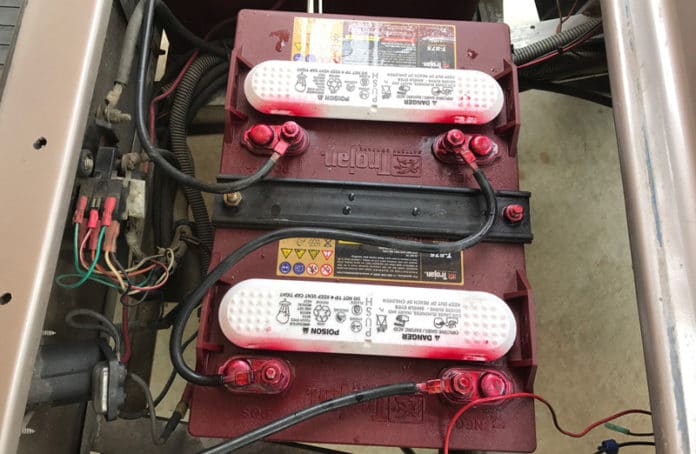
As part of a series, we will provide information on the top battery types available for golf carts. For our first deep-dive, we will be taking an in-depth look at lead-acid batteries, because you may be wondering if the lead-acid battery is the best option for your current or future golf cart. It is a valid question in the midst of so many other options coming into the market. The Lead Acid technology was designed in 1859 by French physician Gaston Plante. This was the first rechargeable battery that was used for commercial purposes. The battery has a low energy-to-weight ratio with the low-energy-to-volume ratio, and it is still capable of providing high levels of surge currents. The lead-acid batteries have a large-power-to-weight ratio which is one of its downsides.
Even in the modern age, the lead chemistry is still widely used in mainstream applications. From RVs to Boats and even cars, there are a multitude of reasons for its popularity. The lead-acid battery is cheap and reliable in terms of cost-per-watt. There are not many batteries that are inexpensive like the lead-acid batteries. It is one of the reasons that lead-acid batteries are used in golf carts, automobiles and uninterruptible power supplies (UPS). In a quick summation, if weight and size are of no consequence but cost is, then a lead acid battery can potentially be a good option. So, in this article, we are going to focus on lead-acid batteries, and hopefully, it will be all you need to know about them to help with decision making and general education.
Therefore, let us take a look at how it works and why it can be potentially a good or bad option.
Looking to Purchase a Golf Cart? Check out our FREE Purchasing Guide Here.
How They Function
The structure of the lead-acid batteries is made from lead alloy. This is because the pure lead is soft and will not be able to support itself. So, a few traces of other metals are added to provide the strength it needs. It can also improve the electrical properties of the lead batteries. The most commonly added metals include:
- Tin
- Calcium
- Antimony
- Selenium
When you add antimony or tin to the lead, it makes the deep cycling better. Unfortunately, this gives rise to the water consumption and increases the need to equalize – or in other words, you have to water the batteries way more often than you should have to. On the other hand, the calcium greatly reduces the self-discharge (how long a charge will last you). More calcium in the battery has the side effect of growing when it is overcharged. The modern lead-acid batteries use tin, cadmium, selenium, and arsenic. This helps in lowering the content of antimony and calcium which can be damaging and increase battery maintenance.
Lead-acid batteries are easy to charge, keeping in mind the correct voltage limits. When you select a low voltage, it protects the battery but it leads to low performance. It will also cause the Sulphur to build up on the negative side of the plates. Sulphur build is bad for the batteries and in most cases is what leads to a battery failure. The reason for this is because the lead plates in a battery are so incredibly close, that too much sulphur build up can cause the places to touch and short circuit an entire battery.
Article: 4 Signs You Need to Replace Your Golf Cart Batteries
Apart from this, the high voltage will boost the performance but will have grid corrosion on the positive plate. The charging of the lead-acid batteries can take up to 14 to 16 hours. It is better to store the batteries at full charge. The reason behind this is that if it is stored without a charge, it will create sulfation as discussed earlier that will impact the performance of the battery in the future and will lead to its over-all failure.
Another aspect of lead acid batteries in golf carts that others point out is the pain of having to maintain their electrolyte levels. In order for a chemical reaction to take place internally in a battery to charge and then supply energy for use (discharge), it needs to be continually hydrated like us humans. As humans we need water, and so does a lead-acid battery. Therefore, in your golf cart, you may find yourself checking the internal acid levels (Yes, it is acid in the battery even though you put water into it) and adding pure distilled H2O (NOT TAP WATER) to the battery as it is needed. One reason to add the water is for the battery to complete a chemical reaction, and another reason to continually adding water on a monthly basis is because the lead plates inside the battery need to be submersed and avoid contact with oxygen-filled air as pure oxygen will quickly damage the lead plates ability to hold and produce a charge.
The lead acid batteries have a moderate lifespan. The lead-acid batteries work great in cold temperatures and can work better than other batteries is sub zero conditions. The opposite is true though for hotter climates. A lead acid battery can sometimes have half the lifespan as it would in a colder climate.
Advantages of Lead-Acid Batteries
There are many advantages of using Lead-acid batteries. Take a look at some of the benefits:
- The lead-acid battery is a better option for golf carts as they are inexpensive
- It is a reliable battery because it has 140 years of development
- The battery can easily bear overcharging
- It can deliver very high currents
- It is one of the most recycled products
- Lead-acid batteries are available in various sizes and capacities
Disadvantage of the Lead-Acid Batteries
Some of the disadvantages of the lead-acid batteries are:
- Lead-acid batteries are heavy and bulky
- They are not ideal for fast charging
- Do not have a long life-time in hot climate areas unless properly cared for
- Need to be watered 1-2 times per month
In the end, lead-acid batteries are good for golf carts as they provide high levels of current and they can tolerate overcharging.







